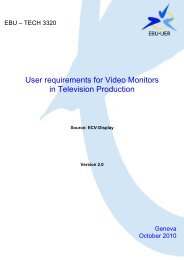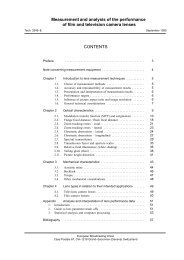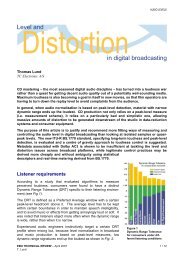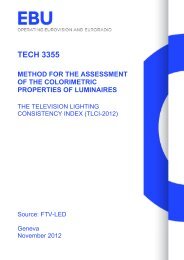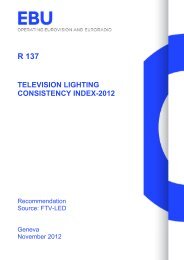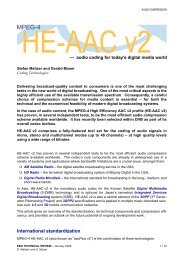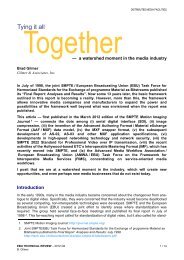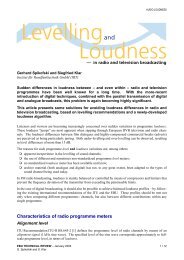Production Technology Seminar 2009 - EBU Technical
Production Technology Seminar 2009 - EBU Technical
Production Technology Seminar 2009 - EBU Technical
You also want an ePaper? Increase the reach of your titles
YUMPU automatically turns print PDFs into web optimized ePapers that Google loves.
45<br />
from a broadcasting perspective, the first 3D boom in 1953/54 (requiring colour film for the anaglyph<br />
filtering) has been commented on as a response to early colour broadcasting in the USA. This latest 3D<br />
dynamic is based on the viewer‟s experience and the proven uplift in 3D vs. 2D release.<br />
3.2.2 Comparison between leap from SD to HD and from HD to 3DHD<br />
Perhaps the most significant consideration for 3DTV is to approach/understand it from a non technical<br />
perspective. Many technologies have been introduced to the public yet the nature and balance between<br />
the consumer experiences vs. the business model has limited appeal. Many broadcasters are still trying<br />
to master HD and may consider 3DTV as something medium/long term. It could be argued this misses<br />
out the fundamental motivation of 3DTV production/broadcast. To a user, the leap from SD to HD is<br />
minor compared with the HD to 3DTV. An advertiser conveying a message in HD is a minor<br />
improvement from SD (message recall, etc) compared with the leap from B&W to colour. Work is<br />
underway to align the advertising community with the 3DTV proposition so it may result in a common<br />
view that a premium is justified. If not, 3DTV might be purely for pay television operators but beyond the<br />
full reach of FTA broadcasters. The table below compares the transition from SD-HD & from HD-3HDTV.<br />
SD to HD HD to 3DHD<br />
A Improvement in picture quality noticed by<br />
engineers – often not by the consumer.<br />
B Business model to produce or broadcast<br />
HD is challenging and perhaps still<br />
presents problems. It is difficult to apply a<br />
premium to that content.<br />
Dramatically and immediately noticeable by consumers ("wow" factor). It‟s<br />
completely different to the first time they would have seen HD.<br />
This depends on the standards process. If you can control access to the 3D<br />
element, so you can apply more flexible business models (e.g. you get<br />
programmes and/or adverts in 2D unless consumer/advertisers have paid a<br />
premium).<br />
C New cameras Mostly same HD cameras (just using special rigs). Can use specialist cameras<br />
for certain shots.<br />
D New infrastructure (HD-SDI) Same infrastructure as in HD (HD-SDI) with some dual path or mezzanine<br />
compression for single path - depending on infrastructure.<br />
E New displays. You either had a SD<br />
television or an HD television.<br />
This depends on the standards process. New displays (but stepping stone via<br />
HD anaglyph, consuming 3D content on an HD display). Perhaps a start with<br />
CGI generated programming once a week etc.<br />
F New editing software New editing software or plug in‟s<br />
G New sets/make up etc (potentially) Same sets/make up as HD.<br />
H 400%+ more bandwidth than SD This depends on the standards process. One option is a full resolution per eye<br />
model. Depending on content, if live or from playout it needs between 30-50%<br />
extra bandwidth than 2DHD. With the 3D model where HD is inside a<br />
dedicated channel it‟s possible to have half resolution per eye and use the<br />
same bandwidth as HD. Thus, that method of 3DTV would be 100% extra.<br />
I No control over access (HD by default) so<br />
long as they could access the channel.<br />
This depends on the standards process. Ability to apply business rules at point<br />
of transmission or in the STB. For example, a 3D STB one-off licence<br />
activation to view content fee for a non advertising PSB for certain channels.<br />
J Not backwards compatible with SD Backwards compatible with 2DHD. Providing the viewer experience to watch<br />
content in 2D (without wearing glasses).<br />
K No real alternative market for 2DHD<br />
content in cinemas - if you can watch it at<br />
home<br />
L By-product of HD can be SD but SD<br />
content is plentiful and that is not a real<br />
value to have an additional SD feed<br />
M HD-STB baseline too quick for<br />
1080p50/60 (format gap) – so is this<br />
format going to happen to the<br />
consumers?<br />
N Not that different to shoot HD compared<br />
to SD<br />
O HD, for many broadcasters, had no<br />
premium felt of value by advertisers. It<br />
was just a bit better colour TV.<br />
Accordingly for FTA broadcasters, HD is<br />
often not easy to monetize.<br />
Cinemas looking for alternative 3D content (can help cover production costs) –<br />
as the production itself can open a new revenue stream by showing it in the<br />
cinemas in 3D.<br />
3DHD “by-product” is 2DHD. Yet this has a strong value as HD content still<br />
commands a premium. Plus again to (2DSD) if the edit compromise was<br />
deemed acceptable.<br />
The 3DHD STB baseline (drawing board) still open – it is possible to include,<br />
or to migrate to 1080p50/60. This is an ideal junction in time.<br />
Shooting good 3D is a new skill, takes time to master. This really is a new way<br />
of involving a viewer and that skill will take time. Recommend to start learning<br />
process at this stage – not when the standards have been finalised & displays<br />
in the shops. 3D will not go away from the cinema and the pressures for<br />
consumer options will increase. In a way it‟s a far greater leap from SD to HD.<br />
This depends on the standards process. Proven uplift with 3D cinema. Sets<br />
precedent (up to 200%). Research on message recall of stereo 3D information<br />
many help brands justify a small increase in advertising to have the option to<br />
advertise in 3D – thus providing a viable business model for advertising based<br />
FTA broadcasters. Similar to B&W to colour.<br />
© <strong>EBU</strong> <strong>2009</strong> / <strong>Production</strong> <strong>Technology</strong> seminar / January 27 - 29, <strong>2009</strong><br />
Reproduction prohibited without written permission of <strong>EBU</strong> TECHNICAL & <strong>EBU</strong> TRAINING



